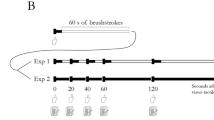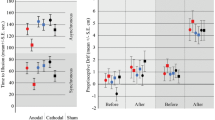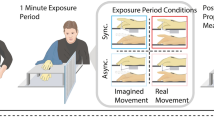Abstract
The rubber hand illusion (RHI) is an experimental paradigm known to produce a bodily illusion. Transcutaneous electrical nerve stimulation (TENS) combined with the RHI induces a stronger illusion than the RHI alone. Visuotactile stimulus synchrony is an important aspect of the RHI. However, the effect of TENS and visuotactile stimulus synchrony in TENS combined with the RHI remains unknown. The purpose of this study was to investigate the effects of TENS and visuotactile stimulus synchrony on the embodiment of an artificial hand when using TENS combined with the RHI. The participants underwent four experimental conditions in random order: TENS/noTENS × Synchronous/Asynchronous. TENS was set at an intensity such that it generated a feeling of electrical paresthesia in the radial nerve area of the hand but did not cause pain, i.e., 100-Hz pulse frequency, 80-µs pulse duration, and a constant pulse pattern. A visuotactile stimulus, either temporally synchronous or asynchronous, was generated using paintbrush strokes. To evaluate the outcome measures, the participants completed a questionnaire report and proprioceptive drift assessments (motor response and perceptual response). There were significant main effects of TENS and visuotactile synchrony, but no interaction between these factors, on the results of the questionnaire and the perceptual response. In contrast, there was no significant effect on the result of the motor response. These findings indicate that TENS and visuotactile synchrony might affect differently the embodiment of an artificial hand when using TENS combined with the RHI.



Similar content being viewed by others
References
Arzy S, Thut G, Mohr C, Michel CM, Blanke O (2006) Neural basis of embodiment: distinct contributions of temporopariet al. junction and extrastriate body area. J Neurosci 26:8074–80781. https://doi.org/10.1523/JNEUROSCI.0745-06.2006
Botvinick M, Cohen J (1998) Rubber hands feel touch that eyes see. Nature 391:756. https://doi.org/10.1038/35784
Christ O, Reiner M (2014) Perspectives and possible applications of the rubber hand and virtual hand illusion in non-invasive rehabilitation: technological improvements and their consequences. Neurosci Biobehav Rev 44:33–44. https://doi.org/10.1016/j.neubiorev.2014.02.013
Costantini M, Robinson J, Migliorati D, Donno B, Ferri F, Northoff G (2016) Temporal limits on rubber hand illusion reflect individuals’ temporal resolution in multisensory perception. Cognition 157:39–48. https://doi.org/10.1016/j.cognition.2016.08.010
Ehrsson HH, Spence C, Passingham RE (2004) That’s my hand! activity in premotor cortex reflects feeling of ownership of a limb. Science 305:875–877
Ehrsson HH, Holmes NP, Passingham RE (2005) Touching a rubber hand: feeling of body ownership is associated with activity in multisensory brain areas. J Neurosci 25:10564–10573. https://doi.org/10.1523/JNEUROSCI.0800-05.2005
Fuchs X, Riemer M, Diers M, Flor H, Trojan J (2016) Perceptual drifts of real and artificial limbs in the rubber hand illusion. Sci Rep 22(6):24362. https://doi.org/10.1038/srep24362
Funk M, Shiffrar M, Brugger P (2005) Hand movement observation by individuals born without hands: phantom limb experience constrains visual limb perception. Exp Brain Res 164:341–346. https://doi.org/10.1007/s00221-005-2255-4
Gallagher S (2000) Philosophical conceptions of the self: implications for cognitive science. Trends Cogn Sci 4:14–21
Gallagher S (2005) How the body shapes the mind. Oxford University, New York
Gallagher S (2011) The oxford handbook of the self. Oxford University, New York
Gallese V, Sinigaglia C (2010) The bodily self as power for action. Neuropsychologia Rev 48:746–755. https://doi.org/10.1016/j.neuropsychologia.2009.09.038
Gandevia SC, Phegan CM (1999) Perceptual distortions of the human body image produced by local anaesthesia, pain and cutaneous stimulation. J Physiol 514.2:609–616. https://doi.org/10.1111/j.1469-7793.1999.609ae.x
Giummarra MJ, Gibson SJ, Georgiou-Karistianis N, Bradshaw JL (2008) Mechanisms underlying embodiment, disembodiment and loss of embodiment. Neurosci Biobehav Rev 32:143–160. https://doi.org/10.1016/j.neubiorev.2007.07.001
Head H, Holms G (1911) Sensory disturbances from cerebral lesions. Brain 34:102–254
Inui N, Walsh LD, Taylor JL, Gandevia SC (2011) Dynamic changes in the perceived posture of the hand during ischaemic anaesthesia of the arm. J Physiol 589:5775–5784. https://doi.org/10.1113/jphysiol.2011.219949
Johnson MI, Bjordal JM (2011) Transcutaneous electrical nerve stimulation for the management of painful conditions: focus on neuropathic pain. Expert Rev Neurother 11:735–753. https://doi.org/10.1586/ern.11.48
Kalckert A, Ehrsson HH (2012) Moving a rubber hand that feels like your own: a dissociation of ownership and agency. Front Hum Neurosci 14:40. https://doi.org/10.3389/fnhum.2012.00040
Kammers MP, de Vignemont F, Verhagen L, Dijkerman HC (2009a) The rubber hand illusion in action. Neuropsychologia 47:204–211. https://doi.org/10.1016/j.neuropsychologia.2008.07.028
Kammers MP, Longo MR, Tsakiris M, Dijkerman HC, Haggard P (2009b) Specificity and coherence of body representations. Perception 38:1804–1820. https://doi.org/10.1068/p6389
Lin S, Sun Q, Wang H, Xie G (2017) Influence of transcutaneous electrical nerve stimulation on spasticity, balance, and walking speed in stroke patients: a systematic review and meta-analysis. J Rehabil Med 50:3–7. https://doi.org/10.2340/16501977-2266
Lloyd DM, Gillis V, Lewis E, Farrell MJ, Morrison I (2013) Pleasant touch moderates the subjective but not objective aspects of body perception. Front Behav Neurosci 23:7:207. https://doi.org/10.3389/fnbeh.2013.00207
Longo MR, Schüür F, Kammers MP, Tsakiris M, Haggard P (2008) What is embodiment? A psychometric approach. Cognition 107:978–998. https://doi.org/10.1016/j.cognition.2007.12.004
Makin TR, Holmes NP, Ehrsson HH (2008) On the other hand: dummy hands and peripersonal space. Behav Brain Res Rev 5(191):1–10. https://doi.org/10.1016/j.bbr.2008.02.041
Melzack R, Wall PD (1965) Pain mechanisms: a new theory. Science 150:971–979
Milne S, Welch V, Brosseau L, Saginur M, Shea B, Tugwell P, Wells G (2001) Transcutaneous electrical nerve stimulation (TENS) for chronic low-back pain. Cochrane Database Syst Rev 2:CD003008. https://doi.org/10.1002/14651858.CD003008/full
Mulvey MR, Fawkner HJ, Radford HE, Johnson MI (2012) Perceptual embodiment of prosthetic limbs by transcutaneous electrical nerve stimulation. Neuromodulation 15:42–47. https://doi.org/10.1111/j.1525-1403.2011.00408.x
Mulvey MR, Fawkner HJ, Johnson MI (2015) An investigation of the effects of different pulse patterns of transcutaneous electrical nerve stimulation (TENS) on perceptual embodiment of a rubber hand in healthy human participants with intact limbs. Neuromodulation 18:744–750. https://doi.org/10.1111/ner.12329
Nnoaham KE, Kumbang J (2008) Transcutaneous electrical nerve stimulation (TENS) for chronic pain. Cochrane Database Syst Rev 3:CD003222. https://doi.org/10.1002/14651858.CD003222.pub2
Ocklenburg S, Peterburs J, Rüther N, Güntürkün O (2012) The rubber hand illusion modulates pseudoneglect. Neurosci Lett 523:158–161. https://doi.org/10.1016/j.neulet.2012.06.068
Olausson H, Wessberg J, Morrison I, McGlone F, Vallbo A (2010) The neurophysiology of unmyelinated tactile afferents. Neurosci Biobehav Rev 34:185–191. https://doi.org/10.1016/j.neubiorev.2008.09.011
Oldfield RC (1971) The assessment and analysis of handedness: the Edinburgh inventory. Neuropsychologia 9:97–113
Paqueron X, Leguen M, Rosenthal D, Coriat P, Willer JC, Danziger N (2003) The phenomenology of body image distortions induced by regional anaesthesia. Brain 126.3:702–712
Proske U, Gandevia SC (2012) The proprioceptive senses: their roles in signaling body shape, body position and movement, and muscle force. Physiol Rev 92:1651–1697. https://doi.org/10.1152/physrev.00048.2011
Riemer M, Kleinböhl D, Hölzl R, Trojan J (2013) Action and perception in the rubber hand illusion. Exp Brain Res 229:383–393. https://doi.org/10.1007/s00221-012-3374-3373
Rohde M, Di Luca M, Ernst MO (2011) The rubber hand illusion: feeling of ownership and proprioceptive drift do not go hand in hand. PLoS One 6:e21659. https://doi.org/10.1371/journal.pone.0021659
Shimada S, Fukuda K, Hiraki K (2009) Rubber hand illusion under delayed visual feedback. PLoS One 4:e6185. https://doi.org/10.1371/journal.pone.0006185
Sluka KA, Walsh D (2003) Transcutaneous electrical nerve stimulation: basic science mechanisms and clinical effectiveness. J Pain 4:109–121. https://doi.org/10.1054/jpai.2003.434
Tsakiris M (2010) My body in the brain: a neurocognitive model of body-ownership. Neuropsychologia 48:703–712. https://doi.org/10.1016/j.neuropsychologia.2009.09.034
Tsakiris M, Haggard P (2005) Experimenting with the acting self. Cogn Neuropsychol 22:387–407. https://doi.org/10.1080/02643290442000158
Tsakiris M, Prabhu G, Haggard P (2006) Having a body versus moving your body: how agency structures body-ownership. Conscious Cogn 15:423–432. https://doi.org/10.1016/j.concog.2005.09.004
Tsakiris M, Hesse MD, Boy C, Haggard P, Fink GR (2007) Neural signatures of body ownership: a sensory network for bodily self-consciousness. Cereb Cortex 17:2235–2244. https://doi.org/10.1093/cercor/bhl131
van Stralen HE, van Zandvoort MJ, Hoppenbrouwers SS, Vissers LM, Kappelle LJ, Dijkerman HC (2014) Affective touch modulates the rubber hand illusion. Cognition 131:147–158. https://doi.org/10.1016/j.cognition.2013.11.020
Walsh LD, Hoad D, Rothwell JC, Gandevia SC, Haggard P (2015) Anaesthesia changes perceived finger width but not finger length. Exp Brain Res 233:1761–1771. https://doi.org/10.1007/s00221-015-4249-1
Zeller D, Hullin M (2018) Spatial attention and the malleability of bodily self in the elderly. Conscious Cogn 59:32–39. https://doi.org/10.1016/j.concog.2018.01.006
Zhu Y, Feng Y, Peng L (2017) Effect of transcutaneous electrical nerve stimulation for pain control after total knee arthroplasty: a systematic review and meta-analysis. J Rehabil Med 49:700–704. https://doi.org/10.2340/16501977-2273
Acknowledgements
This work was supported by a Grant-in-Aid for Exploratory Research from Niigata University of Health and Welfare, 2017. The authors would like to thank Editage for editorial assistance with the manuscript.
Author information
Authors and Affiliations
Contributions
AA and KS conceived of the study and designed the experimental paradigm. AA, KY, and YK performed the experiment and analyzed the data. AA wrote the manuscript. KS provided feedback and edited the manuscript. All authors read and approved the final manuscript.
Corresponding author
Ethics declarations
Conflict of interest
The authors declare that they have no conflict of interest.
Ethical approval
All procedures performed in studies involving human participants were in accordance with the ethical standards of the institutional and/or national research committee and with the 1964 Helsinki Declaration and its later amendments or comparable ethical standards.
Rights and permissions
About this article
Cite this article
Asao, A., Shibuya, K., Yamada, K. et al. Effects of transcutaneous electrical nerve stimulation and visuotactile synchrony on the embodiment of an artificial hand. Exp Brain Res 237, 81–89 (2019). https://doi.org/10.1007/s00221-018-5398-9
Received:
Accepted:
Published:
Issue Date:
DOI: https://doi.org/10.1007/s00221-018-5398-9




